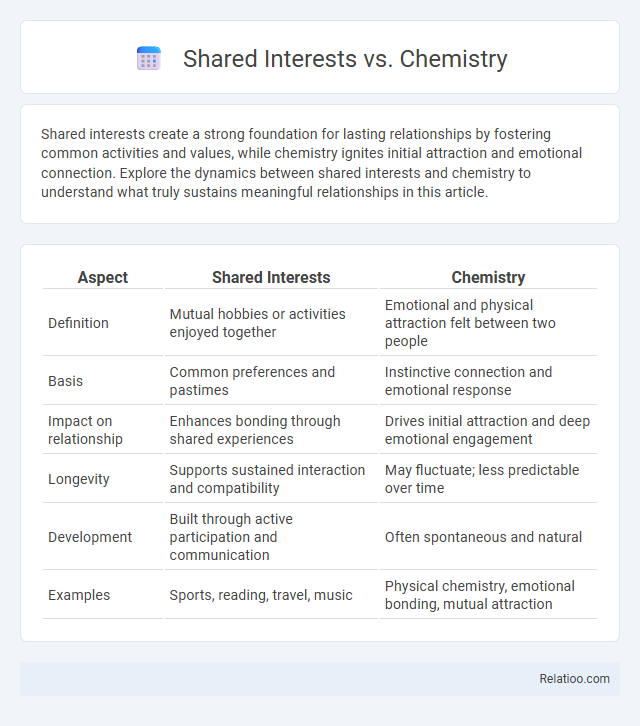Shared interests create a strong foundation for lasting relationships by fostering common activities and values, while chemistry ignites initial attraction and emotional connection. Explore the dynamics between shared interests and chemistry to understand what truly sustains meaningful relationships in this article.
Table of Comparison
| Aspect | Shared Interests | Chemistry |
|---|---|---|
| Definition | Mutual hobbies or activities enjoyed together | Emotional and physical attraction felt between two people |
| Basis | Common preferences and pastimes | Instinctive connection and emotional response |
| Impact on relationship | Enhances bonding through shared experiences | Drives initial attraction and deep emotional engagement |
| Longevity | Supports sustained interaction and compatibility | May fluctuate; less predictable over time |
| Development | Built through active participation and communication | Often spontaneous and natural |
| Examples | Sports, reading, travel, music | Physical chemistry, emotional bonding, mutual attraction |
Defining Shared Interests and Chemistry
Shared interests form a foundation for meaningful connections by aligning your hobbies, values, and passions with someone else's. Chemistry involves an intangible emotional and physical attraction that creates an immediate, magnetic bond beyond common activities. Understanding the difference helps you recognize when a relationship thrives on compatibility versus a deeper, instinctive connection.
The Role of Shared Interests in Relationships
Shared interests form a crucial foundation for lasting relationships by fostering mutual understanding and shared experiences that strengthen emotional bonds. Your ability to engage in activities and hobbies together builds trust and creates meaningful connections beyond initial chemistry or discovery phases. Prioritizing shared interests enhances communication and compatibility, sustaining relationship growth over time.
Understanding the Nature of Chemistry
Chemistry is an intangible force that goes beyond shared interests, highlighting a natural, often instant, emotional and physical connection between individuals. While shared interests provide common ground for communication and bonding, chemistry fuels attraction and a deeper desire to engage on multiple levels. Understanding the nature of chemistry helps you recognize why some connections spark effortlessly, even without extensive commonalities.
How Shared Interests Influence Compatibility
Shared interests create a foundation for compatibility by fostering mutual understanding and engagement in activities both partners enjoy. This alignment enhances communication and builds emotional connections, increasing the likelihood of long-term relationship satisfaction. While chemistry and discovery contribute to attraction and growth, shared interests anchor compatibility by promoting consistent quality time and shared goals.
The Science Behind Romantic Chemistry
The science behind romantic chemistry reveals that shared interests alone cannot ignite the biochemical reactions driving attraction, which mainly involve neurotransmitters like dopamine, norepinephrine, and oxytocin. Discovery moments activate reward circuits in the brain, enhancing emotional bonding and creating a sense of excitement crucial for romantic chemistry. Understanding these physiological processes explains why chemistry feels spontaneous and why shared interests support but do not replace the biological foundation of attraction.
Shared Interests: Building a Foundation
Shared interests create a solid foundation for lasting relationships by fostering common ground and mutual understanding. When you engage in activities or hobbies both partners enjoy, trust and communication naturally strengthen. Prioritizing shared interests helps your connection grow deeper and more meaningful over time.
Chemistry: The Spark That Ignites Attraction
Chemistry represents the intangible spark that ignites attraction, transcending shared interests and initial discovery in relationships. It involves a powerful emotional and physical connection that fosters intimacy and creates a magnetic bond between individuals. Unlike shared interests, chemistry triggers an immediate, often unexplainable response that compels people to deepen their connection and explore emotional compatibility.
Balancing Shared Interests and Chemistry
Balancing shared interests and chemistry is essential for a thriving relationship, as shared interests provide common ground for activities and conversations while chemistry fuels emotional connection and attraction. Couples who prioritize both tend to experience greater compatibility and long-term satisfaction, combining intellectual engagement with passionate connection. Focusing solely on shared interests may lead to friendships lacking spark, whereas relying only on chemistry might result in unstable or short-lived bonds.
Can Relationships Thrive on Chemistry Alone?
Relationships built solely on chemistry often lack the stability provided by shared interests and ongoing discovery of each other's values and goals. While chemistry ignites initial attraction, sustained connection depends on mutual experiences, aligned priorities, and continuous personal growth together. Couples who invest in shared interests and emotional discovery cultivate deeper bonds that outlast fleeting passion.
Finding Harmony Between Interests and Chemistry
Balancing shared interests with chemistry creates a foundation for meaningful connections, as mutual passions foster engagement while chemistry ignites emotional resonance. Prioritizing both ensures relationships evolve naturally, combining intellectual compatibility with emotional attraction. This harmony enhances communication and deepens bonds, promoting long-term fulfillment.

Infographic: Shared Interests vs Chemistry
 relatioo.com
relatioo.com